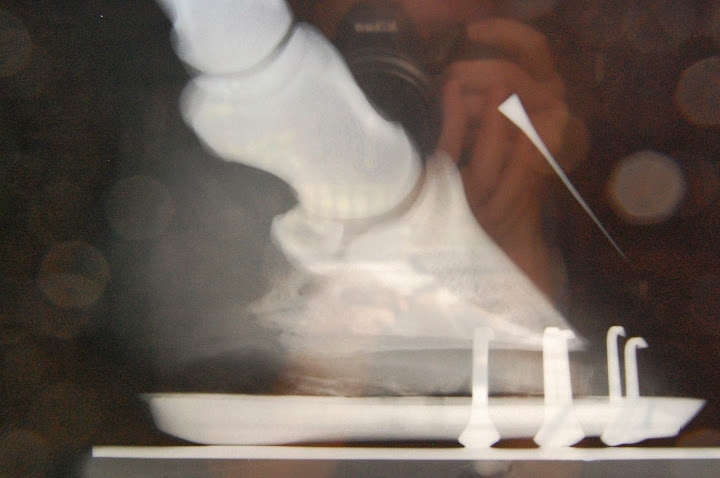I can't believe it's been a year since Buttercup's hoof rehab began. It was Oct. 13, 2008, when I finally sought advice on the internet and acknowledged that something was horribly wrong with my horse.
One of the first things I did was get X-rays so the farrier and the vet could assess the damage. You can never tell the true extent of hoof damage without X-rays. If something is off about your horse's hooves, it pays to get these done. And don't make excuses! My vet charges a pretty penny for antiquated film X-rays. Sure, I want lessons and to keep riding with my horse in rehab, but priorities are key. Bottom line: you need them.
The last few weeks I have really worked to educate myself further on the subject of inside the horse's hoof, and before I give you the X-rays, I want to share information on the internal structure. That way, we can all be on the same page. I'm also reading up a lot on massage, myofasial and stretching techniques, but that's another post for another day.
So let's take a look inside that hoof:

(snagged from a google search/ azequinerescue.org)
Essentially, there are three main internal parts: P1 (P for Phalanx), P2 and P3. P1 is proximal phalanx or pastern, P2 is middle phalanx (P1 and 2 a joint above the coronary band) and P3 is the pedal or coffin bone. And underneath P2 and behind P3 is navicular (the bone of the dreaded Navicular Disease).

This is Buttercup's front right from October 2008. Unfortunately, my picture of this film X-ray has cut off the P1 a bit and reduced the quality. The nail seen in the photo marks the top of the coronary band, and it kind of follows the outer hoof wall. However, most vets nowadays use a glue that shows up on X-rays that follows the hoof wall better than a static nail.
Remember, this hoof suffered the least amount of damage during the poor farrier work. But you can already see a "lipping" at the tip of the pedal bone. As it has been explained to me, this is from lack of blood flow and the bone starting to alter.
The pedal bone has not begun to sunk yet, but it looks like it's thinking about it given the lack of blood flow. Also, note how far back inside the hoof is the head of the P3 and how flat the hoof looks.
Not incredibly amounts of damage, but no good omens either. This hoof was in dire need of change since nothing good could happen in its current condition.
One year later:

The most obvious change is lack of shoe, but that's really secondary to all the changes we see. 1) the top P3 is in better relation to the front of the hoof; 2) There is no "sunken" look to this pedal bone; and 3) although the sole depth is minimum, there is visible concavity to the hoof. Please notice how the tip of the pedal (P3) bone is permanently scarred. Although we are pretty certain that blood flow has been restored, Buttercup's skeleton has been altered from the ordeal.
Now onto the more extreme:

In the left front, the P3 is definitely more sunken than the right front. When the coffin/pedal bone sinks, this is called "rotation." Although this X-ray does not show an extreme rotation, it is about 1-2 degrees of rotation. Like the front right but with more damage, the tip of the coffin bone has been lipped from lack of blood flow. The sole is flat and this hoof is down right ugly.
Here's how it looks today:

Even to the uneducated eye, changes are apparent. Many of the changes are similar to the changes on the right hoof, only more visible since this hoof altered so much (for bad and good). It no longer appears "sunken" and concavity is forming in the sole. These are great signs for returned blood flow. Of course, the pedal bone will remain scarred.
With a lot of positives these past few months, we are now ready to address the rest of Buttercup's body. Her hoof problems have relayed throughout her body to create other changes in her body. Think about limping around for a few hours. Your other leg will begin to hurt, and so will your back. The same is true for a quadruped.
I actually stopped riding her Oct. 3, because 1) the move to her new barn caused her hooves to go through a reconditioning process, making her sensitive for a week or so, and 2) I realized her lack of cadence was not from being out of condition, but from changes to her skeletal and muscular system in response to her hoof problems over the last year and half.
Here is a picture of her moving out of cadence, which I think is the direct result of the hoof issues:

I made a calculated risk when I brought her back into work in August. I misjudged the severity of the damage to the body.
When the vet was out for X-rays a week back, I had her assess Buttercup's overall body. Her 7th neck bone (C7) is out and she has several ribs out, in addition to being very tight and sore over her withers and the lumbar area.
To address these issues, I have been doing my best to learn massage and proper stretching with Equine Massage: A practical guide, and I scheduled an appointment for Oct. 30 with a chiropractor who also performs acupuncture. Although the bones need to be reset, her muscle memory and tightness may pull them back to where they were, the acupuncture, stretching and massage will hopefully prevent that from happening.
Then, beginning with light work and progressing nicely, new muscle memory will be formed to keep her bones in place. If something pops out again, we will have to have another session.






